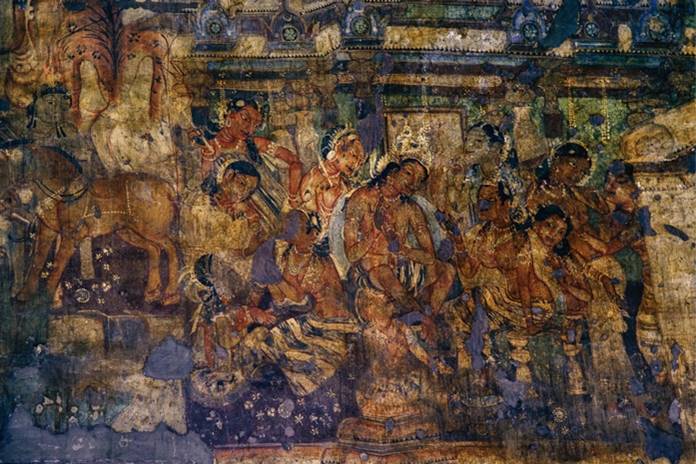Deepshikha
Cave paintings are oldest form of wall art or simply ‘art’ known to humankind made by the early men with crude tools and natural colours to depict their daily life. Many renowned cave art are found all over the world such as – Lascaux – France, Altamira – Spain, Argentina, Indonesia, Coliboaia – Romania, Nawarla Gabarnmang – Australia as well as India. This article presents a summary of the cave paintings and art forms of India. The most renowned ones include – Bhimbedka Cave Paintings – near Bhopal in Madhya Pradesh; Sittanavasal Paintings – Puddukotai district of Tamil Nadu; Ajanta Caves – near Aurangabad in Maharashtra; Ellora Caves – near Aurangabad in Maharashtra; Lenyadri cave paintings – Junnar in Pune district in Maharashtra; Badami Caves – Bagalkot district in Northern Karnataka; Adamgarh Hills – Hoshangabad town in Madhya Pradesh; Jogimara Cave Paintings – Chattisgarh; Saspol Caves – Saspol village in Leh district; Elephanta Caves – Ellora Island in Maharashtra.
Bhimbetka Caves
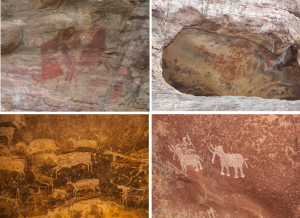
Bhimbetka is located in Raisen district in Bhopal, Madhya Pradesh and is recognized as a UNESCO world heritage. There are around 750 rock shelters spread around in an area of more than 10 kilometers. They are assumed to be older than 10,000 years belonging to the Indian Mesolithic era. The theme of the rock art is mostly animals, dancing and hunting carvings.
Ajanta Cave Paintings
Ajanta caves are 30 rock cut Buddhist caves dating from second century BC to 480 CE located in Aurangabad in Maharashtra. It is assumed to have been built and completed in two phases 2nd century BCE to 1st century CE and again after several centuries. It is also a UNESCO world heritage site and a protected monument listed under Archaeological Survey of India. A 75-meter-long wall, nests ancient monasteries – Viharas and worship halls – Chaityas. Caves 1,2, 16 and 17 have the largest surviving paintings elaborated in rich colours depicting the life of Buddha, rebirths of Buddha and tales from Aryasura’s Jatakamala.
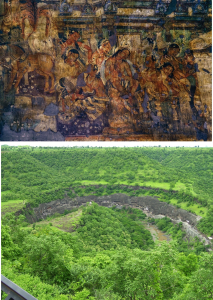
Kanheri, Elephanta and Ellora caves
Kanheri caves are rock cut monuments situated in the outskirts of Mumbai in the forests of Sanjay Gandhi National Park, easily accessible by local transportation. The word kanheri is derived from the Sanskrit term Krishnagiri which literally translates into ‘black mountain’. The Buddhist sculptures, paintings and inscriptions,
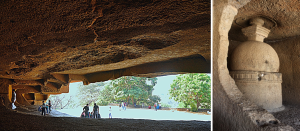
relief carvings date from the 1st century CE to the 10th century CE. Majority of the caves were used for meditation, studying and rest – viharas and others functioned as worship halls – Chaityas.
Elephanta caves are located 10kms away from Mumbai in the Elephanta island on Mumbai Harbour. It is accessible by water transport available at the Gateway of India. It comprises 5 Hindu caves and 2 Buddhist caves and Stupa mounds. The most spectacular carvings are that of Trimurti Sadashiva (three-faced Shiva), Nataraja (Lord of dance) and Yogishvara (Lord of Yoga). The caves are dated between 5th-9th century CE.
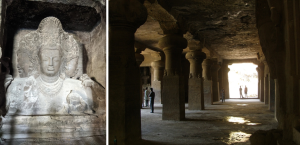
Courtesy- Wikipedia
Ellora caves is a UNESCO world heritage site situated in Aurangabad, Maharashtra. It dates between 600-1000 CE. The largest monolithinc rock cut temple – the Kailash temple- is present in cave 16 which the most celebrated monument here. There are 12 Buddhist caves (1–12, 17 Hindu caves (13–29) and 5 Jain caves (30–34) apart from the 66 other caves present. Only the mentioned 34 are opened to public.
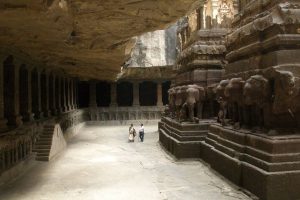
Courtesy- Wikipedia
Satkunda Rock Paintings
These rock paintings are also located near Bhopal, Madhya Pradesh and are assumed to be older than 5000 years. The paintings are pictographic carvings that depict daily life of the tribal communities that resided in forests.
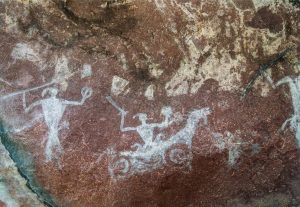
Courtesy- Outlook India
Saspol Caves, Ladakh
The caves are under the administration of Likir Monastery residing in the hills behind Saspol, Ladakh. 2 out of 5 cave paintings are extensively damaged. Paintings of Anuttarayoga Tantra, also known as Yoganiruttaratantra, is present in the main cave. Conservation projects were carried out by the INTACH Ladakh Chapter in 2015 and 2016.
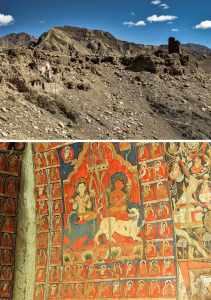
Courtesy- Wikipedia
References
- https://www.outlookindia.com/outlooktraveller/see/story/69098/on-a-cave-art-trail-in-india
- https://pickyourtrail.com/blog/cave-paintings/
- https://yehaindia.com/cave-paintings-in-india/

